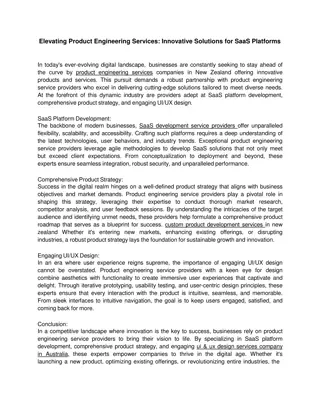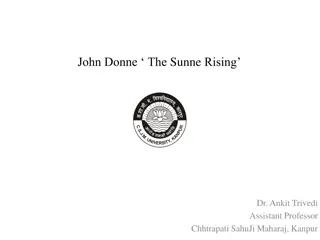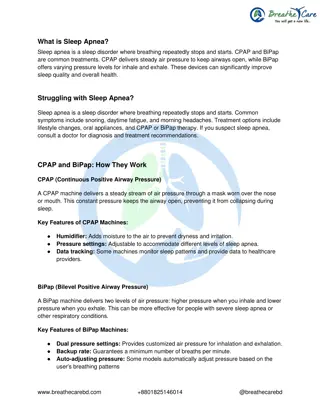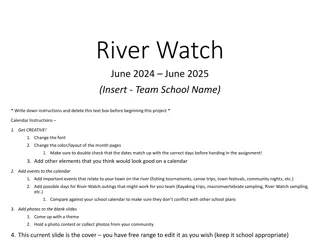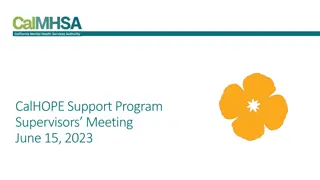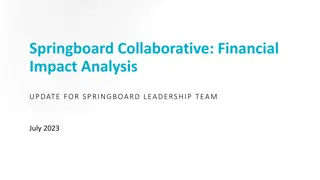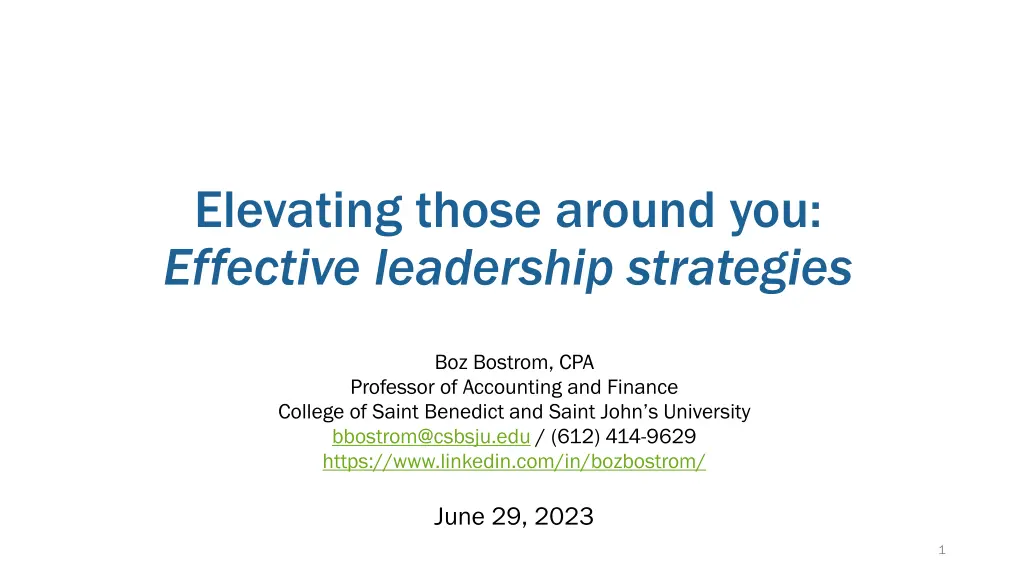
Effective Leadership Strategies for Elevating Those Around You
Explore effective leadership strategies and qualities taught by Boz Bostrom, CPA, to elevate those around you. Learn about key leadership qualities, benefits of effective leadership, and how to differentiate between managing and leading. Gain insights on becoming a successful leader who inspires others to follow.
Download Presentation

Please find below an Image/Link to download the presentation.
The content on the website is provided AS IS for your information and personal use only. It may not be sold, licensed, or shared on other websites without obtaining consent from the author. If you encounter any issues during the download, it is possible that the publisher has removed the file from their server.
You are allowed to download the files provided on this website for personal or commercial use, subject to the condition that they are used lawfully. All files are the property of their respective owners.
The content on the website is provided AS IS for your information and personal use only. It may not be sold, licensed, or shared on other websites without obtaining consent from the author.
E N D
Presentation Transcript
Elevating those around you: Effective leadership strategies Boz Bostrom, CPA Professor of Accounting and Finance College of Saint Benedict and Saint John s University bbostrom@csbsju.edu / (612) 414-9629 https://www.linkedin.com/in/bozbostrom/ June 29, 2023 1
Logistics Polling questions throughout the meeting Required for CPE If you have issues answering the polling questions, please chat or email across your answer 2.0 CPE Hours in Personal Development (Non-technical) Partial credit available minimum of 1.0 hour Questions (and tips) are very welcome, submit through chat at any time Course evaluation and CPE Certificate will be emailed later today 2
Learning objectives Understand key qualities of effective leaders Understand benefits of effective leadership Learn from effective leaders 3
Overview An introduction to leadership A concise view of leadership Leadership Qualities Communication styles Thinking about criticism Benefits of effective leadership 4
An introduction to leadership Leadership is hard to define and good leadership even harder. But if you can get people to follow you to the ends of the earth, you are a great leader. - Indra Nooyi 5
Managing vs. Leading https://www.youtube.com/watch?v=nSUJwmPQEyg Managing: being responsible for a job Leading: being responsible for the people who are responsible for the job One person can work perhaps 3,500 hours in a year If that person is leading a team of 20 people, they have influence over 40,000+ hours per year When everything goes right, you have to give away all the credit, and when everything goes wrong, you have to take all the responsibility. Simon Sinek 7
Polling Question 1: How would you best describe yourself vs. Leading a. A leader b. A manager c. Somewhere in between d. Other 8
Discussion Think of the worst leaders you have had in your life. What made them poor leaders? Think of the best leaders you have had in your life. What made them great leaders? 9
Ken Blanchard Author, consultant, speaker The One Minute Manager has sold over 15M copies https://www.youtube.com/w atch?v=ctZHSa4Qhd4 11
Servant leadership Serve first, lead second Most effective leaders are good human beings who care about people Listen more than talk 13
Tips to success Enter your day slowly, and with intent Be intentional. Don t get caught in the rat race Self assess at the end of each day Praise and redirect yourself Focus on significance instead of success Significance is tied to generosity, success is tied to money 14
Three key aspects of being a leader Set clear goals People need to know what they must try to accomplish Praise others Catch someone doing something good! Redirect Point out the issue, ask for their opinion, ask how you can help them get back on track Which comes easiest and hardest for you? 15
Polling Question 2: Which do you most struggle with? a. Setting clear goals b. Praising others c. Providing redirection 16
1. 2. Your manager checks in on you constantly. When asking you to complete a task, your manager tells you, in detail, how to complete the assignment. Your manager indicates being swamped at work but refuses to delegate any projects to you. Your manager wants constant status reports on the progress of a project. Your manager gives you a task to complete but later decides to do it him or herself. Your manager has a tendency to withhold information because he or she doesn t think you need to know. Your manager requires you to seek his or her permission before you start a task. You constantly feel anxious around your manager and are afraid of making a mistake. Your manager constantly questions your judgment and decision-making. 10. Others around you refer to your manager as a micromanager. 3. 4. 5. 6. 7. 8. 9. 17 https://www.melissallarena.com/boss-micromanager-take-quiz-find/
Management styles Managers need to provide direction, ensure deadlines are met, correct mistakes, and achieve results How can we balance those needs without micromanaging? 18
Polling Question 3: What is the one non- negotiable quality a good leader must possess? a. Ambition b. Integrity c. Strong Work ethic d. Vision 21
What is the one non-negotiable quality a good leader must possess? Integrity 22
Dr. Henry Cloud Integrity Establishing trust Orienting toward truth Getting results Embracing the negative Orienting toward increase Orienting toward transcendence 23
Establishing trust Trust is about the heart gain someone s trust and you gain their desire and passion Empathy Listen in a way that communicates understanding Avoid invalidation Or they will find someone who will validate them Do others feel like they need to watch their backs around you? Be FOR others Possess strength and likeness, be warm and imperfect 24
Orienting toward truth People can deal with the truth, however unpleasant, they can t deal with deceit Consequences of deceit are larger Seek reality / don t assume you know everything Give up false security 25
Career Builder Survey What percent of workers admitting they tell lies at the office at least once a week? 19% What percent of managers say they have fired an employee for being dishonest? 24% What percent of workers reported they were caught in a lie at the office? 15% What percent of hiring managers say they are less likely to promote an employee who has lied to them or other members of the organization? 85% 26
Career Builder Survey Over 2,000 hiring managers and HR professionals 51% would dismiss a candidate if a lie is caught. Most common lies: Embellished skill set Embellished responsibilities Dates of employment Job title Academic degree Companies worked for Accolades/awards 27 27
Most memorable resume lies Applicant included father s job experience Applicant claimed to have been a high school basketball free throw champion. Applicant claimed to be the assistant to the prime minister of a foreign country, but Country doesn t have a prime minister Applicant claimed to have been a construction supervisor, but Bulk of his experience was in the completion of a doghouse Applicant claimed to have 25 years of experience, but Was only 32 years old 28 28
Industries where lies are more likely Financial Services Leisure and Hospitality Information Technology Health Care Retail 29 29
Getting results Have a well defined identity What are you good at vs. not Spend energies accordingly Surround yourself with those who complement you Are you a #2 or a #1? Either is fine Avoid rash decisions Hiring the charming person Make decisions when needed / hard calls Cut your losses and move on Lose well, and you will learn to lose less 30
Did Reggie Lose Well? All time rank in hits? 85th All time rank in homeruns? 13th All time rank in strikeouts? 1st All time rank in consecutive homeruns in a World Series Game? 1st 31
Embracing the negative Face into problems Schedule tough discussions Separate your person from the results Leaders take ownership for results / no blame Be careful/ how tough you are on people when they make mistakes Confront in a way that shows you care about a person Avoid doing things that make you cringe 32
Orienting toward increase Strive to become more than you are Exercise your brain like your muscles What is put to use grows Will you look different in a year? Believe that growth can happen and enable others Risk in increments Surrounded yourself with those who push you to grow and invest in growing others Make wise choices with your time make time for the important 33
Business Insider Article 150 years ago, how many hours per week did people work on average? 70 Today, how many hours per week do people work on average? 40 Today, how many hours per week do people watch TV? 28 So, We figured out how to save ourselves about 30 hours of work per week, and we use them to watch TV. http://www.businessinsider.com/how-humans-spend-their-time-2014-12 34
Orienting toward transcendence It s not about you Response to crisis situations (Hurricane Katrina) Duty to society (PepsiCo) 35
Polling Question 4: Which trait of integrity is the most difficult for you? a. Establishing trust b. Orienting toward truth c. Getting results d. Embracing the negative e. Orienting toward increase f. Orienting toward transcendence g. Other 36
A good leader is a person of integrity, and someone who 37
Passive Not expressing feelings or needs; ignoring your own personal rights and allowing others to do so Deferring to others for decision making in order to avoid tension or conflict Often leads to misunderstanding, built-up anger, or resentment Examples include statements like I m okay with whatever you want to do ; body language includes failing to make eye contact or looking down. 40
Aggressive Expressing feelings, needs, and ideas at the expense of others; ignoring others rights in order to support your own Defensive or hostile when confronted by others Often alienates and hurts others Can help meet your needs quickly Examples include statements like this is what we re doing, or get over it ; body language includes crossing arms, eye rolling, or finger pointing. 41
Passive-Aggressive Appearing passive on the surface, but subtly acting out anger Exerting control over others by using sarcasm and indirect communication, or avoiding the conversation Limited consideration for the rights, needs, or feelings of others Examples include passive statements and body language followed by giving the "silent treatment", spreading rumors, and sabotaging another person s efforts. 42
Assertive Direct, honest communication of thoughts and feelings Respecting the feelings, ideas, and needs of others while also asserting your own People often misinterpret assertive behavior as aggressive Americans and women are often mislabeled as a result Examples include I statements like I feel...when you and I need for you to do ; body language includes eye contact, straight posture, and relaxed gestures. 43
Communication Styles https://umatter.princeton.edu/respect/tools/communication-styles Not expressing feelings or needs; ignoring your own personal rights and allowing others to do so Deferring to others for decision making in order to avoid tension or conflict Often leads to misunderstanding, built-up anger, or resentment Can be a safer communication option when a conflict may escalate to violence Examples include statements like I m okay with whatever you want to do ; body language includes failing to make eye contact or looking down. Passive Passive Expressing feelings, needs, and ideas at the expense of others; ignoring others rights in order to support your own Defensive or hostile when confronted by others Often alienates and hurts others Can help meet your needs quickly Examples include statements like this is what we re doing, or get over it ; body language includes crossing arms, eye rolling, or finger pointing. Aggressive Aggressive Passive Passive- -Aggressive Aggressive Appearing passive on the surface, but subtly acting out anger Exerting control over others by using sarcasm and indirect communication, or avoiding the conversation Limited consideration for the rights, needs, or feelings of others Examples include passive statements and body language followed by giving the "silent treatment", spreading rumors, and sabotaging another person s efforts. Assertive Assertive Direct, honest communication of thoughts and feelings Respecting the feelings, ideas, and needs of others while also asserting your own May not be effective when interacting with individuals that threaten your personal safety People often misinterpret assertive behavior as aggressive Americans and women are often mislabeled as a result Examples include I statements like I feel...when you and I need for you to do ; body language includes eye contact, straight posture, and relaxed gestures. 44
Polling Question 5: When you are not being assertive, which communication style do you gravitate toward? a. Passive b. Aggressive c. Passive-Aggressive 45
Communication Styles We are striving for assertive What do you need to do to become more assertive in your communication? Which of the other three styles would best describe you when you aren t being assertive What are the risks of that style? 46
Harvard Business Review article 47% said that developing their senior leadership team was surprisingly challenging. 48% said that finding time for themselves and for self-reflection was harder than expected. 50% said driving culture change was more difficult than they d anticipated. 68% acknowledged that, in hindsight, they weren t fully prepared to take on the CEO role. Remarked one: When you become the final decision-maker, everything changes. It s hard to train on this. https://hbr.org/2018/07/survey-68-of-ceos-admit-they-werent-prepared-for-the-job 48
Leaders will face critics Which should you listen to? Which should you largely ignore? 49





